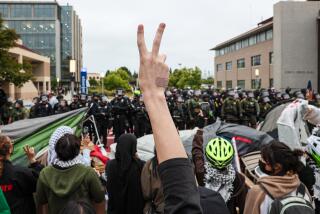Mideast Immigrants’ Effect Weighed
WASHINGTON — Immigration from the Middle East has been so heavy in recent years--and is expected to continue at such high levels--that it is likely to have significant political and social implications in the United States, some demographers and other experts say.
The number of Middle Eastern immigrants in the United States has grown from fewer than 200,000 in 1970 to almost 1.5 million in 2000. The portion who are Muslims has jumped from 15% in 1970 to 73% in 2000, according to an analysis of census data released Wednesday by the Center for Immigration Studies, a Washington-based group that supports limits on immigration.
“Their successful integration is more important than people had realized in the past,” said Steven Camarota, who wrote the report for the group.
However, some groups of Middle Eastern Americans and experts on immigration criticized the report’s authors for using the data to try to further their aim of reducing immigration.
“The anti-immigrant groups have risen up and discovered they can use the Muslim boogeyman to try to achieve their objective,” said James Zogby, president of the Arab American Institute.
“It begins with the assumption that Muslims are scary; they are a danger to America. And then it seeks to put together faulty data with bad analysis to prove the point,” said Zogby, whose group works for civic and political influence for Americans of Arab descent.
However, Zogby did agree with the basic findings of the report: that Middle Eastern immigrants are on the rise and that more of them are Muslims.
Zogby and Camarota also agreed that one of the likely effects of having more Muslim immigrants voting in U.S. elections is that U.S. foreign policy toward the Middle East will probably become less tilted toward Israel.
“This is an emerging counterweight to the people who feel very strongly about the Arab-Israeli conflict on the other side,” Camarota said.
“I sure hope it has an impact,” Zogby said. “I sure hope it makes our policy more sensitive. It may not alter the policy in every instance, but it does help shape the discussion.”
The increase in Muslim immigrants was noticeable earlier this year when three Democratic House members from Michigan, where concentrations of Muslim immigrants are high, were among the 21 voting against a resolution expressing solidarity with Israel in its fight against terrorism.
Scholars who spoke at a news conference Wednesday announcing the report stressed the possible negative effects from the increase of Muslim immigrants from the Middle East.
Daniel Pipes, director of the Middle East Forum, a Washington-based think tank that seeks to promote U.S. interests in the Middle East, said that American authorities have to do more to prevent even a small number of militant Islamic activists from slipping into the country as immigrants, visitors or students.
“This is our enemy; we must not let it into our house,” he said.
He asserted that most of the institutions created by Muslim immigrants are Islamist and are working against mainstream American principles.
However, Zogby accused Pipes of misrepresenting Muslim immigrants.
“They didn’t come here to Islamize America,” Zogby said. “They came here for economic opportunity and political freedom--the same reasons other people come to America.”
Muslim immigrants and their children, who are bicultural and bilingual, are helping American companies expand into the Middle East and assisting the U.S. government in understanding the complicated region, he said.
Frederick Denny, a University of Colorado professor whose research focuses on Muslims in America, said that since Sept. 11, the image of respectable Muslim immigrants has been thrown out of focus by the attention to militant Islam.
“A lot has been done to reinforce negative stereotypes since Sept. 11, and negative attitudes are more freely expressed,” said Denny, who chairs the department of religious studies. “I’m very concerned about this.”
By contrast, his research has made him optimistic about Muslim immigrants in America and their ability to integrate into the society and make it richer.
“Through my research of a dozen or more years, I have seen Muslim communities in America be tremendously valuable human resources,” he said.
The report found that Middle Eastern immigrants constitute one of the most educated immigrant groups.
In 2000, 49% had at least a bachelor’s degree, compared with 28% of natives.
The median earnings for Middle Eastern men were $39,000, slightly higher than the average for native workers.
And Middle Eastern immigrants were more likely to become citizens than other immigrants to the United States. Approximately 55% held American citizenship in 2000, compared with 38% of immigrants overall.
(BEGIN TEXT OF INFOBOX)
A Growing Force
Immigrants from the Middle East living in the United States.
Where They Are The states with the largest numbers of Middle Eastern immigrants as of 2000:
California 392,400 New York 244,900 Texas 101,900 Michigan 93,400 Virginia 81,100 New Jersey 78,400 Illinois 71,100 Florida 55,100
Where They Came From The most common countries of origin of the Middle East immigrants in the United States as of 2000:
Iran 279,100 Pakistan 269,800 Israel 123,700 Iraq 112,600 Bangladesh 103,300 Turkey 91,200 Egypt 87,300 Lebanon 83,400
Source: Center for Immigration Studies/U.S. Census
More to Read
Sign up for Essential California
The most important California stories and recommendations in your inbox every morning.
You may occasionally receive promotional content from the Los Angeles Times.










